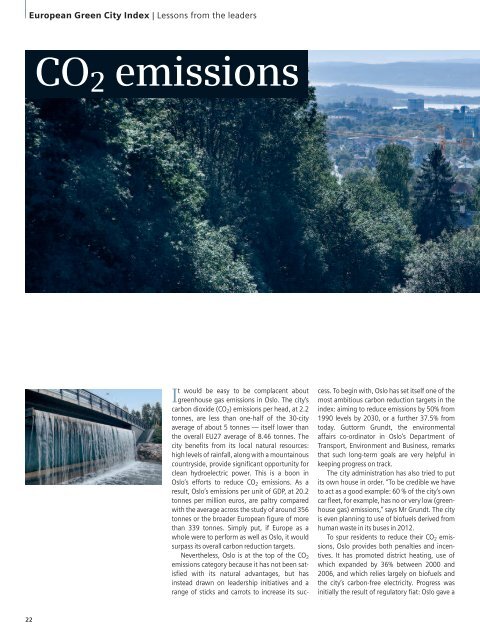European Green City Index - Siemens
European Green City Index - Siemens
European Green City Index - Siemens
You also want an ePaper? Increase the reach of your titles
YUMPU automatically turns print PDFs into web optimized ePapers that Google loves.
<strong>European</strong> <strong>Green</strong> <strong>City</strong> <strong>Index</strong> | Lessons from the leaders<br />
CO2 emissions<br />
It would be easy to be complacent about<br />
greenhouse gas emissions in Oslo. The city’s<br />
carbon dioxide (CO2) emissions per head, at 2.2<br />
tonnes, are less than one-half of the 30-city<br />
average of about 5 tonnes — itself lower than<br />
the overall EU27 average of 8.46 tonnes. The<br />
city benefits from its local natural resources:<br />
high levels of rainfall, along with a mountainous<br />
countryside, provide significant opportunity for<br />
clean hydroelectric power. This is a boon in<br />
Oslo’s efforts to reduce CO2 emissions. As a<br />
result, Oslo’s emissions per unit of GDP, at 20.2<br />
tonnes per million euros, are paltry compared<br />
with the average across the study of around 356<br />
tonnes or the broader <strong>European</strong> figure of more<br />
than 339 tonnes. Simply put, if Europe as a<br />
whole were to perform as well as Oslo, it would<br />
surpass its overall carbon reduction targets.<br />
Nevertheless, Oslo is at the top of the CO2<br />
emissions category because it has not been satisfied<br />
with its natural advantages, but has<br />
instead drawn on leadership initiatives and a<br />
range of sticks and carrots to increase its suc-<br />
cess. To begin with, Oslo has set itself one of the<br />
most ambitious carbon reduction targets in the<br />
index: aiming to reduce emissions by 50% from<br />
1990 levels by 2030, or a further 37.5% from<br />
today. Guttorm Grundt, the environmental<br />
affairs co-ordinator in Oslo’s Department of<br />
Transport, Environment and Business, remarks<br />
that such long-term goals are very helpful in<br />
keeping progress on track.<br />
The city administration has also tried to put<br />
its own house in order. “To be credible we have<br />
to act as a good example: 60 % of the city’s own<br />
car fleet, for example, has no or very low (greenhouse<br />
gas) emissions,” says Mr Grundt. The city<br />
is even planning to use of biofuels derived from<br />
human waste in its buses in 2012.<br />
To spur residents to reduce their CO2 emissions,<br />
Oslo provides both penalties and incentives.<br />
It has promoted district heating, use of<br />
which expanded by 36% between 2000 and<br />
2006, and which relies largely on biofuels and<br />
the city’s carbon-free electricity. Progress was<br />
initially the result of regulatory fiat: Oslo gave a<br />
monopoly to a district heating company, which<br />
it largely owned, to provide all heat to any new<br />
or thoroughly renovated buildings by refusing<br />
permits to any construction plan that had other<br />
sources of supply. At the same time, it required<br />
municipal buildings to convert to district heating<br />
and exerted strong moral pressure on other public<br />
institutions such as hospitals and universities.<br />
Mr Grundt says that others are now seeking the<br />
service for commercial reasons. “More and more<br />
private owners and developers are joining,” he<br />
notes. “The prices are not much cheaper, but district<br />
heating involves a lot less maintenance.”<br />
The city has also taken an active role in reducing<br />
transport-related CO2 emissions. Here, the<br />
stick — in the form of Oslo’s congestion charge<br />
— has had some effect, cutting existing traffic<br />
by between 4% and 7% since its introduction.<br />
Moreover, the charge has stopped private vehicle<br />
travel from increasing in line with the city’s<br />
fast growing population.<br />
For those residents who wish to continue driving,<br />
despite Oslo’s good public transport,<br />
another emission-reduction strategy is the<br />
switching of fuels. The city is encouraging the<br />
use of electric and hybrid cars through various<br />
inducements, including the waiving of city tolls<br />
and parking charges, as well as the establishment<br />
of electric charging points. “It started with<br />
the enthusiasts,” notes Mr Grundt. “They formed<br />
an association and put pressure on the politicians<br />
to change the rules.” One key step was<br />
allowing commuters with electric or hybrid vehicles<br />
to drive in the city's dedicated public transport<br />
lanes. As a result, the Oslo region now has<br />
about 1,700 electric-only vehicles, excluding<br />
hybrid cars.<br />
Other strategies have also made judicious<br />
use of taxes and inducements. The city’s €100<br />
million Climate and Energy Fund, for example,<br />
was funded by a tax on local electricity. Among<br />
other things, it now provides a 50% grant for the<br />
conversion of oil heaters to ones powered by<br />
biofuels. With similar national grants in place,<br />
Mr Grundt argues that there is “no excuse left<br />
not to change.”<br />
Ideas from<br />
other cities<br />
Berlin’s renewable energy focus is on solar<br />
power. Among the city’s many initiatives is<br />
Europe’s largest photovoltaic system on a residential<br />
building, which produces 25,000<br />
kwh annually.<br />
Helsinki now has the world’s largest heat<br />
pump, under centrally located Katri Vala Park.<br />
It uses heat from wastewater and seawater to<br />
provide district heating and cooling.<br />
In January 2008, Madrid approved a €14<br />
million Ecobarrio project to revitalise several<br />
run-down neighbourhoods. These will include<br />
a thermoelectric plant using biogas<br />
from urban waste treatment and buildings<br />
that capture solar power.<br />
In Paris, Aéroports de Paris has launched an<br />
intra-company car-sharing network. If just 5%<br />
of airport employees use the network regularly,<br />
it will save around 4,000 tonnes of CO2<br />
emissions.<br />
Copenhagen has set an ambitious goal of<br />
becoming carbon neutral by 2025, building<br />
on its existing climate plan which targets 50<br />
specific initiatives in energy production,<br />
transport, buildings and consumption.<br />
22 23

















